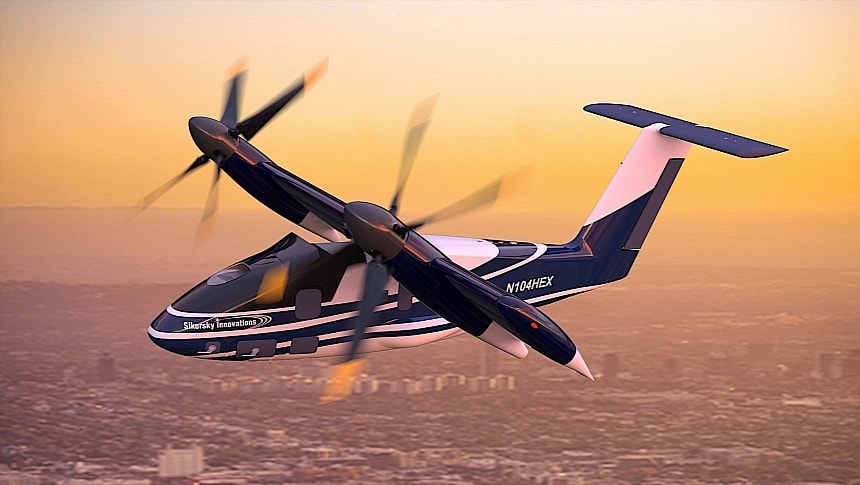The world of electric vertical take-off and landing (eVTOL) aircraft is a very fascinating one. Just think about it: who wouldn't like to travel fast across the cities of the world in machines that are essentially a cross between a helicopter and an airplane, instead of using the good old car?
The nascent industry as it stands today is fueled mostly by start-ups that have seen the opportunity and are trying to seize it. There are literally hundreds of designs that have made it into the open in recent years, each in various stages of development and with various chances of success.
So far not a single company from the old guard of aviation has truly joined the VTOL party. That will probably change in the near future, as they will all see there is no turning back from this, and these kinds of flying machines are the way of the future.
A good hint this is the way things are going to go is the announcement made this week by Sikorsky. The century-old American company, responsible to a great extent for the rise of the helicopter, once more confirmed that it is planning to build, test, and fly a VTOL.
And not just any kind of VTOL, but one powered by a hybrid-electric drivetrain, in a tilt-wing configuration (something Sikorsky is becoming an expert at) and featuring a high degree of autonomy.
So far called HEX/VTOL, the project first came into the spotlight in the spring of last year, but now we're learning a few more details about it, and we also get to see it for the first time.
The demonstrator, which will have a gross weight of 9,000 pounds (4,082 kg), will be powered by a hybrid-electric system centered around a 600 kW electric motor and a 1.2 MW-class turbogenerator.
The range of the Sikorsky VTOL should be 575 miles (925 km), but we still don't know how fast it is supposed to fly – we're only told to expect "high speed."
The aircraft will be using fewer mechanical systems than we're used to, making it less complex and cheaper to maintain. More importantly, the autonomy features it will use will be based on the Matrix technology that helped a Black Hawk helicopter fly completely unmanned back in 2022. It is the same tech deployed on the modified S-76B medium-size rotorcraft called Sikorsky Autonomy Research Aircraft (SARA).
The company expects the HEX to become the "first in a series of large, next-generation VTOL aircraft" with various degrees of electrification and automation that will be used by both the civilian and military worlds.
There is no timeframe yet as to when we should expect the HEX demonstrator to get here, but this week's announcement also gave us a clearer picture as what to expect, design-wise, in the rendering displayed as the main photo of this piece.
So far not a single company from the old guard of aviation has truly joined the VTOL party. That will probably change in the near future, as they will all see there is no turning back from this, and these kinds of flying machines are the way of the future.
A good hint this is the way things are going to go is the announcement made this week by Sikorsky. The century-old American company, responsible to a great extent for the rise of the helicopter, once more confirmed that it is planning to build, test, and fly a VTOL.
And not just any kind of VTOL, but one powered by a hybrid-electric drivetrain, in a tilt-wing configuration (something Sikorsky is becoming an expert at) and featuring a high degree of autonomy.
So far called HEX/VTOL, the project first came into the spotlight in the spring of last year, but now we're learning a few more details about it, and we also get to see it for the first time.
The demonstrator, which will have a gross weight of 9,000 pounds (4,082 kg), will be powered by a hybrid-electric system centered around a 600 kW electric motor and a 1.2 MW-class turbogenerator.
The range of the Sikorsky VTOL should be 575 miles (925 km), but we still don't know how fast it is supposed to fly – we're only told to expect "high speed."
The aircraft will be using fewer mechanical systems than we're used to, making it less complex and cheaper to maintain. More importantly, the autonomy features it will use will be based on the Matrix technology that helped a Black Hawk helicopter fly completely unmanned back in 2022. It is the same tech deployed on the modified S-76B medium-size rotorcraft called Sikorsky Autonomy Research Aircraft (SARA).
The company expects the HEX to become the "first in a series of large, next-generation VTOL aircraft" with various degrees of electrification and automation that will be used by both the civilian and military worlds.
There is no timeframe yet as to when we should expect the HEX demonstrator to get here, but this week's announcement also gave us a clearer picture as what to expect, design-wise, in the rendering displayed as the main photo of this piece.











